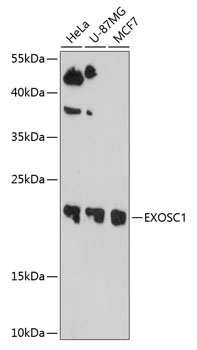Epigenetics & Nuclear Signaling Antibodies 1
Anti-EXOSC1 Antibody (CAB10302)
- SKU:
- CAB10302
- Product Type:
- Antibody
- Reactivity:
- Human
- Host Species:
- Rabbit
- Isotype:
- IgG
- Antibody Type:
- Polyclonal Antibody
- Research Area:
- Epigenetics and Nuclear Signaling
Description
| Antibody Name: | Anti-EXOSC1 Antibody |
| Antibody SKU: | CAB10302 |
| Antibody Size: | 20uL, 50uL, 100uL |
| Application: | WB |
| Reactivity: | Human |
| Host Species: | Rabbit |
| Immunogen: | Recombinant fusion protein containing a sequence corresponding to amino acids 1-195 of human EXOSC1 (NP_057130.1). |
| Application: | WB |
| Recommended Dilution: | WB 1:500 - 1:2000 |
| Reactivity: | Human |
| Positive Samples: | HeLa, U-87MG, MCF7 |
| Immunogen: | Recombinant fusion protein containing a sequence corresponding to amino acids 1-195 of human EXOSC1 (NP_057130.1). |
| Purification Method: | Affinity purification |
| Storage Buffer: | Store at -20'C. Avoid freeze / thaw cycles. Buffer: PBS with 0.02% sodium azide, 50% glycerol, pH7.3. |
| Isotype: | IgG |
| Sequence: | MAPP VRYC IPGE RLCN LEEG SPGS GTYT RHGY IFSS LAGC LMKS SENG ALPV VSVV RETE SQLL PDVG AIVT CKVS SINS RFAK VHIL YVGS MPLK NSFR GTIR KEDV RATE KDKV EIYK SFRP GDIV LAKV ISLG DAQS NYLL TTAE NELG VVVA HSES GIQM VPIS WCEM QCPK THTK EFRK VARV QPEF LQT |
| Gene ID: | 51013 |
| Uniprot: | Q9Y3B2 |
| Cellular Location: | Cytoplasm, Nucleus, nucleolus |
| Calculated MW: | 21kDa |
| Observed MW: | 21kDa |
| Synonyms: | EXOSC1, CGI-108, CSL4, Csl4p, SKI4, Ski4p, p13 |
| Background: | This gene encodes a core component of the exosome. The mammalian exosome is required for rapid degradation of AU rich element-containing RNAs but not for poly(A) shortening. The association of this protein with the exosome is mediated by protein-protein interactions with ribosomal RNA-processing protein 42 and ribosomal RNA-processing protein 46. Alternative splicing of this gene results in multiple transcript variants. |
| UniProt Protein Function: | EXOSC1: Non-catalytic component of the RNA exosome complex which has 3'->5' exoribonuclease activity and participates in a multitude of cellular RNA processing and degradation events. In the nucleus, the RNA exosome complex is involved in proper maturation of stable RNA species such as rRNA, snRNA and snoRNA, in the elimination of RNA processing by-products and non-coding 'pervasive' transcripts, such as antisense RNA species and promoter-upstream transcripts (PROMPTs), and of mRNAs with processing defects, thereby limiting or excluding their export to the cytoplasm. The RNA exosome may be involved in Ig class switch recombination (CSR) and/or Ig variable region somatic hypermutation (SHM) by targeting AICDA deamination activity to transcribed dsDNA substrates. In the cytoplasm, the RNA exosome complex is involved in general mRNA turnover and specifically degrades inherently unstable mRNAs containing AU-rich elements (AREs) within their 3' untranslated regions, and in RNA surveillance pathways, preventing translation of aberrant mRNAs. It seems to be involved in degradation of histone mRNA. The catalytic inactive RNA exosome core complex of 9 subunits (Exo-9) is proposed to play a pivotal role in the binding and presentation of RNA for ribonucleolysis, and to serve as a scaffold for the association with catalytic subunits and accessory proteins or complexes. EXOSC1 as peripheral part of the Exo-9 complex stabilizes the hexameric ring of RNase PH-domain subunits through contacts with EXOSC6 and EXOSC8. |
| UniProt Protein Details: | Protein type:Nucleolus; RNA-binding; EC 3.1.13.-; Ribonuclease Chromosomal Location of Human Ortholog: 10q24 Cellular Component: nucleoplasm; cytoplasm; nucleolus; exosome (RNase complex); cytosol; nucleus; nuclear exosome (RNase complex) Molecular Function:protein binding; exoribonuclease activity; RNA binding Biological Process: gene expression; rRNA processing; mRNA catabolic process, deadenylation-dependent decay |
| NCBI Summary: | This gene encodes a core component of the exosome. The mammalian exosome is required for rapid degradation of AU rich element-containing RNAs but not for poly(A) shortening. The association of this protein with the exosome is mediated by protein-protein interactions with ribosomal RNA-processing protein 42 and ribosomal RNA-processing protein 46. [provided by RefSeq, Jul 2008] |
| UniProt Code: | Q9Y3B2 |
| NCBI GenInfo Identifier: | 14285410 |
| NCBI Gene ID: | 51013 |
| NCBI Accession: | Q9Y3B2.1 |
| UniProt Secondary Accession: | Q9Y3B2,Q5JTH3, B2R9B3, |
| UniProt Related Accession: | Q9Y3B2 |
| Molecular Weight: | 21,452 Da |
| NCBI Full Name: | Exosome complex component CSL4 |
| NCBI Synonym Full Names: | exosome component 1 |
| NCBI Official Symbol: | EXOSC1 |
| NCBI Official Synonym Symbols: | p13; CSL4; SKI4; Csl4p; Ski4p; hCsl4p; CGI-108 |
| NCBI Protein Information: | exosome complex component CSL4; 3'-5' exoribonuclease CSL4 homolog; CSL4 exosomal core protein homolog; exosomal core protein CSL4; homolog of yeast exosomal core protein CSL4 |
| UniProt Protein Name: | Exosome complex component CSL4 |
| UniProt Synonym Protein Names: | Exosome component 1 |
| UniProt Gene Name: | EXOSC1 |
| UniProt Entry Name: | EXOS1_HUMAN |
View AllClose







